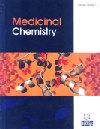In Silico Studies of Phytoconstituents to Identify Potential Inhibitors for ERα Protein of Breast Cancer
IF 2.6
4区 医学
Q3 CHEMISTRY, MEDICINAL
引用次数: 0
Abstract
Background: It is noteworthy that a wide array of plants and nutraceuticals are effectively utilized in the treatment of various cancers, demonstrating potent effects on different cancer targets with fewer side effects. Notably, estrogen alpha has been identified as a crucial factor in breast cancer cell proliferation. Agents that can antagonize its action hold promise as potential drug leads for the treatment of breast cancer. Objective: This study aims to discover and identify the potential inhibitors against the most influential ERα receptor by the computational approach of 134 phytochemicals from 17 medicinal plants by using in silico docking studies. Methods: The molecular docking was performedby a genetic algorithm using the Auto Dock Vina program, and the validation of docking was also performed by using Molecular Dynamic (MD) simulation by the Desmond tool of Schrödinger molecular modeling. Drug-likeness properties and toxicity studies were conducted using SWISS PRO. Results: The top ten highest binding energy phytochemicals ginicidin (-10.8 kcal/mol), lemairone (-10.5 kcal/mol), ixoratannin (-10.0 kcal/mol), hydnocarpine (-9.8 kcal/mol), arabelline (-9.8 kcal/mol), acutilobine E (-9.8 kcal/mol), chaparinone (-8.9 kcal/mol), plumieride coumerate (-8.8 kcal/mol), acutilobine C (-8.7 kcal/mol), and mezerein (-8.7 kcal/mol) were taken for drug-likeness test and ADMET profile prediction with the help of web-based server SWISS ADME and protoxII. Docking's study dictated that ten phytochemical constituents showed greater binding interactions than standard tamoxifen (-6.6 kcal/mol) towards the target protein ERα. MSD study was achieved for the most active 4 phytoconstituents, and the stability of the ligand-protein complex was confirmed and showed that all the four compounds possess comparatively stable ligand-protein complexes with ERα target as compared to the tamoxifen-ERα complex. Conclusion: Among the top ten phytochemicals, ginicidin (glycoside) formed a more stable complex and had greater binding affinity than standard tamoxifen with better safety profiles. Hence, this compound can be further studied for lead optimization and drug development for the treatment of breast cancer.通过植物成分的硅学研究确定乳腺癌 ERα 蛋白的潜在抑制剂
背景:值得注意的是,多种植物和营养保健品被有效地用于治疗各种癌症,对不同的癌症靶点产生了强效作用,且副作用较小。值得注意的是,雌激素α已被确定为乳腺癌细胞增殖的关键因素。能够拮抗其作用的制剂有望成为治疗乳腺癌的潜在药物线索。研究目的本研究旨在通过对 17 种药用植物中的 134 种植物化学物质进行计算研究,并利用硅学对接研究发现和确定针对最具影响力的 ERα 受体的潜在抑制剂。方法:利用Auto Dock Vina程序的遗传算法进行分子对接,并利用薛定谔分子建模工具Desmond进行分子动力学(MD)模拟,对对接进行验证。使用 SWISS PRO 进行了药物相似性和毒性研究。结果:结合能最高的前十种植物化学物质分别是:人参皂苷(-10.8 kcal/mol)、利麦隆(-10.5 kcal/mol)、ixoratannin(-10.0 kcal/mol)、hydnocarpine(-9.8 kcal/mol)、阿拉伯茶碱(-9.8 kcal/mol)、acutilobine E(-9.8 kcal/mol)、chaparinone(-8.9 kcal/mol)、胭脂虫苷(-8.8 kcal/mol)、阿库替罗滨 C(-8.7 kcal/mol)和mezerein(-8.7 kcal/mol)进行了药物相似性测试,并在网络服务器 SWISS ADME 和 protoxII 的帮助下进行了 ADMET 分析预测。Docking 研究表明,与标准他莫昔芬(-6.6 kcal/mol)相比,十种植物化学成分与靶蛋白 ERα 的结合相互作用更大。对最具活性的 4 种植物化学成分进行了 MSD 研究,并确认了配体-蛋白质复合物的稳定性,结果表明与他莫昔芬-ERα 复合物相比,所有这 4 种化合物与 ERα 靶蛋白的配体-蛋白质复合物都相对稳定。结论在排名前十的植物化学物质中,人参皂苷(苷)形成的复合物更稳定,与标准他莫昔芬的结合亲和力更强,安全性更好。因此,可进一步研究该化合物,以优化先导化合物并开发治疗乳腺癌的药物。
本文章由计算机程序翻译,如有差异,请以英文原文为准。
求助全文
约1分钟内获得全文
求助全文
来源期刊

Medicinal Chemistry
医学-医药化学
CiteScore
4.30
自引率
4.30%
发文量
109
审稿时长
12 months
期刊介绍:
Aims & Scope
Medicinal Chemistry a peer-reviewed journal, aims to cover all the latest outstanding developments in medicinal chemistry and rational drug design. The journal publishes original research, mini-review articles and guest edited thematic issues covering recent research and developments in the field. Articles are published rapidly by taking full advantage of Internet technology for both the submission and peer review of manuscripts. Medicinal Chemistry is an essential journal for all involved in drug design and discovery.
 求助内容:
求助内容: 应助结果提醒方式:
应助结果提醒方式:


